-
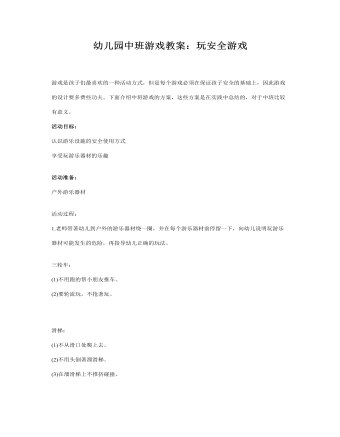
幼儿园中班安全教案:玩安全游戏
活动目标:认识游乐设施的安全使用方式享受玩游乐器材的乐趣活动准备:户外游乐器材活动过程:1.老师带著幼儿到户外的游乐器材绕一圈,并在每个游乐器材前停留一下,向幼儿说明玩游乐器材可能发生的危险,再指导幼儿正确的玩法。
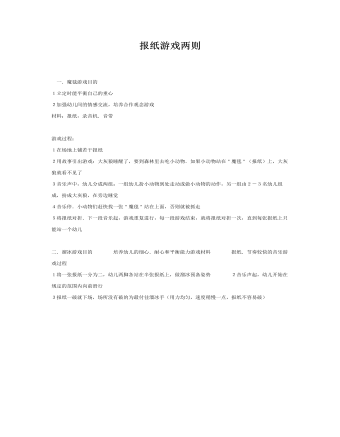
中班体育教案:报纸游戏两则
游戏过程:1在场地上铺若干报纸 2用故事引出游戏:大灰狼睡醒了,要到森林里去吃小动物.如果小动物站在"魔毯"(报纸)上,大灰狼就看不见了 3音乐声中,幼儿分成两组:一组幼儿扮小动物到处走动或做小动物的动作,另一组由2-3名幼儿组成,扮成大灰狼,在旁边睡觉 4音乐停.小动物们赶快找一张"魔毯"站在上面,否则就被抓走
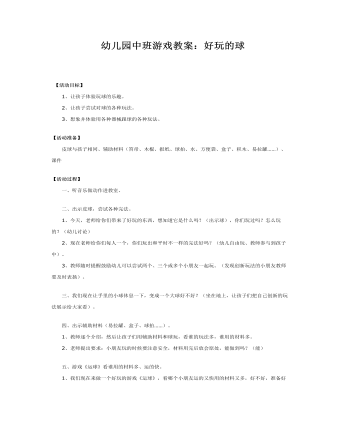
幼儿园中班游戏教案:好玩的球
2、让孩子尝试对球的各种玩法。3、想象并体验用各种器械跟球的各种玩法。【活动准备】 皮球与孩子相同、辅助材料(笤帚、木棍、报纸、球拍、水、方便袋、盒子、积木、易拉罐……)、课件【活动过程】 一、听音乐做动作进教室。 二、出示皮球,尝试各种完法。1、今天,老师给你们带来了好玩的东西,想知道它是什么吗?(出示球),你们玩过吗?怎么玩的?(幼儿讨论)2、现在老师给你们每人一个,你们玩出和平时不一样的完法好吗?(幼儿自由玩、教师参与到孩子中)。3、教师随时提醒鼓励幼儿可以尝试两个、三个或多个小朋友一起玩。(发现创新玩法的小朋友教师要及时表扬)。
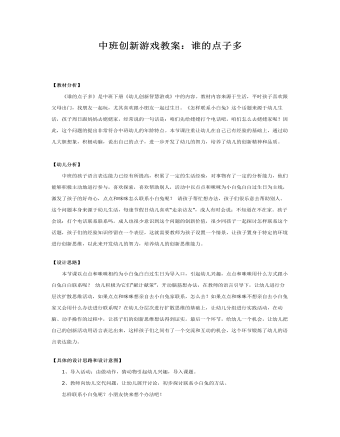
中班创新游戏教案:谁的点子多
【幼儿分析】 中班的孩子语言表达能力已经有所提高,积累了一定的生活经验,对事物有了一定的分析能力,他们能够积极主动地进行参与,喜欢探索,喜欢帮助别人,活动中以点点和咪咪为小白兔白白过生日为主线,激发了孩子的好奇心,点点和咪咪怎么联系小白兔呢?请孩子帮忙想办法,孩子们很乐意去帮助别人。这个问题本身来源于幼儿生活,每逢节假日幼儿喜欢“走亲访友”,成人有时会说:不知道在不在家。孩子会说:打个电话联系联系吗。成人也很少意识到这个问题的创新价值,很少同孩子一起探讨怎样联系这个话题,孩子们的经验知识停留在一个表层,这就需要教师为孩子设置一个情景,让孩子置身于特定的环境进行创新思维,以此来开发幼儿的智力,培养幼儿的创新思维能力。【设计思路】 本节课以点点和咪咪相约为小白兔白白过生日为导入口,引起幼儿兴趣,点点和咪咪用什么方式跟小白兔白白联系呢?幼儿积极为它们“献计献策”,开动脑筋想办法,在教师的语言引导下,让幼儿进行分层次扩散思维活动,如果点点和咪咪想亲自去小白兔家联系,怎么去?如果点点和咪咪不想亲自去小白兔家又会用什么办法进行联系呢?在幼儿分层次进行扩散思维的基础上,让幼儿分组进行实践活动,在动脑、动手操作的过程中,让孩子们的创新思维想法得到证实。最后一个环节,给幼儿一个机会,让幼儿把自己的创新活动用语言表达出来,这样孩子们之间有了一个交流和互动的机会,这个环节锻炼了幼儿的语言表达能力。

中班主题课件教案:快乐游乐园
活动目标:1.能够动脑筋想出各种跳和爬的方法. 2.克服困难、勇于挑战,体验成功和集体运动的快乐.环境创设:运动区域:跑跳区 活动器材:轮胎 圈 梅花桩 竹梯 大滚桶 海洋球 休息区域:长凳 生活用具:毛巾 衣筐(把生活用具作为标志,放在休息区域提示孩子自主保育)活动流程:热身运动→幼儿自主活动→分享交流→再次探索→游戏→整理场地活动过程:一.热身运动“今天,罗老师带我们小朋友到游乐园去玩,游乐园里有轮胎、 圈、 竹梯、梅花桩、大滚桶搭成的路,一会我们小朋友可以到这几条路上去玩一玩,跳一跳、爬一爬,看看谁的本领大。”“你们觉得我们在游乐场玩的时候,应该怎么样才不会伤到自己和别人?”“当两个小朋友撞在一起怎么办?”(引导幼儿从一个方向开始,不可以插队的。”“要是玩累了就在长凳上休息一下,擦擦汗。”思考:在活动前向幼儿讲清活动 要求,因为在前几次的活动中发现他们走竹梯、轮胎时没有秩序,插队的幼儿很多,这样幼儿就会影响幼儿活动的质量。二.幼儿分散活动,教师观察指导。1.幼儿参与活动的兴趣、投入程度。2.材料的选择情况、摆放情况、合适性如何?(作适当的调整)3.个别幼儿的活动情况并以玩伴的身份参与游戏。4.提示运动量强、易出汗的幼儿檫汗休息,用语言鼓励内向、不喜欢参加集体活动的幼儿。思考:我班幼儿不愿意参加集体活动的幼儿比较多,所以在活动进行中教师必须要关注这些幼儿,给他们以鼓励和表扬,让他们尽快加入到集体活动中来,体验集体活动的快乐。
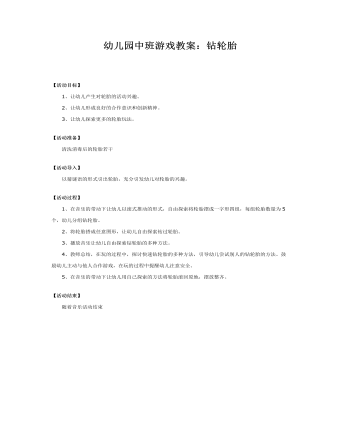
幼儿园中班游戏教案:钻轮胎
2、让幼儿形成良好的合作意识和创新精神。3、让幼儿探索更多的轮胎玩法。【活动准备】 清洗消毒后的轮胎若干【活动导入】 以猜谜语的形式引出轮胎,充分引发幼儿对轮胎的兴趣。
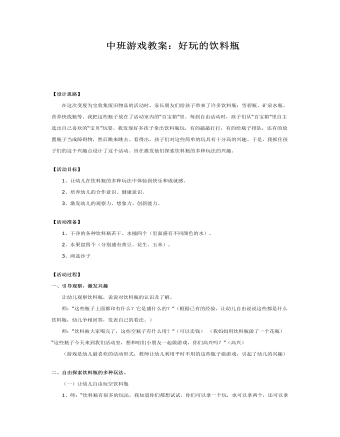
中班游戏教案:好玩的饮料瓶
【活动目标】1、让幼儿在饮料瓶的多种玩法中体验到快乐和成就感。2、培养幼儿的合作意识、健康意识。3、激发幼儿的观察力、想象力、创新能力。【活动准备】1、干净的各种饮料瓶若干、水桶四个(里面盛有不同颜色的水)。2、水果盘四个(分别盛有黄豆、花生、玉米)。3、两盆沙子【活动过程】一、引导观察,激发兴趣 让幼儿观察饮料瓶,说说对饮料瓶的认识及了解。 师:“这些瓶子上面都印有什么?它是盛什么的?”(根据已有的经验,让幼儿自由说说这些都是什么饮料瓶,幼儿争相回答,发表自己的看法。) 师:“饮料被大家喝完了,这些空瓶子有什么用?”(可以卖钱)(我妈妈用饮料瓶做了一个花瓶)“这些瓶子今天来到我们活动室,想和咱们小朋友一起做游戏,你们高兴吗?”(高兴) (游戏是幼儿最喜欢的活动形式,教师让幼儿利用平时不用的这些瓶子做游戏,引起了幼儿的兴趣)
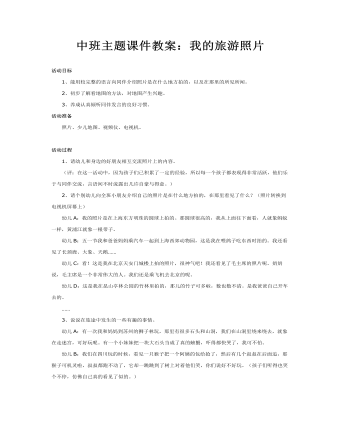
中班主题课件教案:我的旅游照片
2、初步了解看地图的方法,对地图产生兴趣。3、养成认真倾听同伴发言的良好习惯。活动准备 照片、少儿地图、视频仪、电视机。 活动过程1、请幼儿和身边的好朋友相互交流照片上的内容。 (评:在这一活动中,因为孩子们已积累了一定的经验,所以每一个孩子都表现得非常活跃,他们乐于与同伴交流,言语间不时流露出几许自豪与得意。)2、请个别幼儿向全班小朋友介绍自己的照片是在什么地方拍的,在那里看见了什么?(照片转换到电视机屏幕上) 幼儿A:我的照片是在上海东方明珠的圆球上拍的。那圆球很高的,我从上面往下面看,人就象蚂蚁一样,黄浦江就象一根带子。 幼儿B:五一节我和爸爸妈妈乘汽车一起到上海西郊动物园,这是我在喂鸽子吃东西时拍的。我还看见了长颈鹿、大象、天鹅…… 幼儿C:看!这是我在北京天安门城楼上拍的照片,很神气吧!我还看见了毛主席的照片呢。奶奶说,毛主席是一个非常伟大的人。我们还是乘飞机去北京的呢。 幼儿D:这是我在昆山亭林公园的竹林里拍的,那儿的竹子可多啦,数也数不清。是我爸爸自己开车去的。……
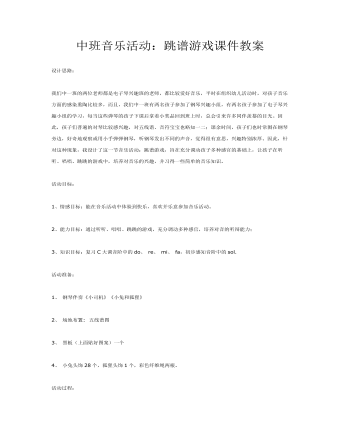
中班音乐活动:跳谱游戏课件教案
活动目标:1、情感目标:能在音乐活动中体验到快乐,喜欢并乐意参加音乐活动。 2、能力目标:通过听听、唱唱、跳跳的游戏,充分调动多种感官,培养对音的听辩能力;3、知识目标:复习C大调音阶中的do、 re、 mi、 fa,初步感知音阶中的sol.活动准备:1、钢琴伴奏《小司机》《小兔和狐狸》2、场地布置: 五线谱图3、黑板(上面贴好图案)一个4、小兔头饰28个,狐狸头饰1个,彩色纤维绳两根。
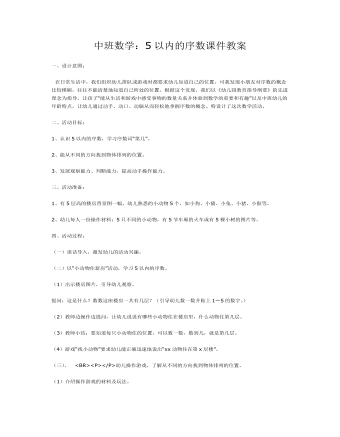
中班数学:5以内的序数课件教案
二、活动目标:1、认识5以内的序数,学习序数词“第几”。2、能从不同的方向找到物体排列的位置。3、发展观察能力、判断能力,提高动手操作能力。三、活动准备:1、有5层高的楼房背景图一幅,幼儿熟悉的小动物5个,如小狗、小猫、小兔、小猪、小猴等。2、幼儿每人一份操作材料:5只不同的小动物,有5节车厢的火车或有5棵小树的图片等。

小学语文修辞手法教案专题课件
1、明喻: 明喻就是本体、喻体和比喻词都出现的比喻。例句:例如:长城像一条长龙。这个句子中,“长城”是本体,“像”是比喻词,“一条长龙”是喻体。2、暗喻: 暗喻又叫隐喻,只出现本体和喻体,不用比喻词语或用“是、变成、成为、等于”等喻词。例句:例如:山间的云雾构成了一幅精妙的山水画。这个句子中“山间的云雾”是本体,“构成”是比喻词,“一幅精妙的山水画”是喻体。3、借喻: 借喻是只出现用来代替本体的喻体,而本体和喻词都不出现。例句:落光了叶子的柳树上挂满了毛茸茸、亮晶晶的银条儿。这个句子中,本体、比喻词均没有出现,喻体是“银条儿”。
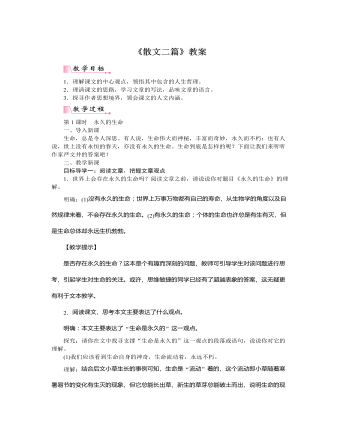
部编版语文八年级上册《散文两篇》教案
目标导学三:理解课文,把握内涵1.作者为什么把追求爱情作为活着的第一条理由?明确:作者说,追求爱情,有三方面的原因:第一,爱情可以带来狂喜;第二,爱情可以解除孤寂;第三,爱情的结合可以使人看到想象的仙境的神秘缩影。总之,爱情使人生活得更加美好;追求爱情,则是追求人生的境界。在这里,作者把爱情描写得极其美好,闪耀着人性的光辉。2.作者为什么追求知识?你能说说知识给你带来了什么吗?明确:一是可以了解人的心灵;二是可以了解星辰为什么发光;三是能够理解毕达哥拉斯的思想威力。这三方面实际上包含了人类知识的几个重要方面:人类、自然和社会。事实上,我们学习的知识,是人类在对世界的好奇心驱使下的创造,它给我们带来的不仅有解开世界之谜的快乐,还有思考过程本身的快乐。
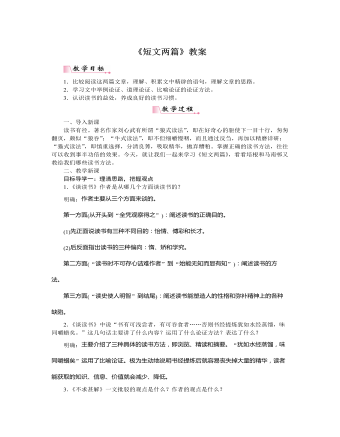
部编版语文九年级下册《短文两篇》教案
4.《不求甚解》一文分析了陶渊明怎样的读书态度,请指出“不求甚解”的两层含义。明确:态度:养成“好读书”的习惯;读书要诀在于“会意”。含义:第一,虚心,书不一定都能读懂;第二,读书方法:不固执一点,而要了解大意。5.《不求甚解》一文是驳论文还是立论文?又是如何驳或者立的?谈一谈你的理解。明确:驳论文。驳的是“论点”,先全面阐述“不求甚解”的含义,进而提倡虚心的“不求甚解”的读书态度,从而表明自己的观点;又从“会意”角度,列举古人读书的例子,并阐明自己的正确论点:读书在会意,不要死抠字眼,为一个局部而放弃整体;最后又强调了“书必须反复读”的主张。这样通过树立自己正确的观点从而驳倒敌论。
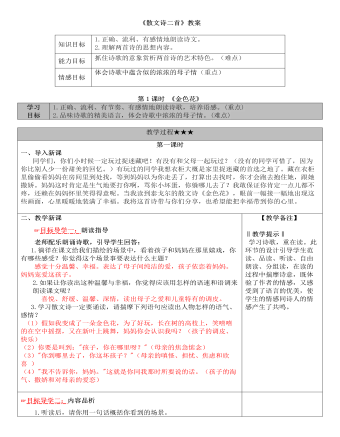
部编版语文七年级上册《散文诗二首》教案
?目标导学三:拓展延伸 1.请你模仿例句仿写。例句:母亲啊!你是荷叶,我是红莲,心中的雨点来了,除了你,谁是我在无遮拦天空下的荫蔽? 仿写: 示例一 :母亲啊,你是流水,我是鱼儿,当干旱来临时,除了你,谁还能为我提供一个安定的家?示例二:母亲啊,你是避风港,我是小船,狂风暴雨来临时,除了你,谁是我在无遮拦大海中的依靠? 示例三:母亲啊,你是鸟巢,我是小鸟,心中的寒冷来了,除了你,谁是我在冷风中的温暖? 2. 人说:天下的母亲有着不一样的面容,但唯有一样——母爱,是完全一样的。同学们,我们享受母爱十余载,那么你们的母亲是如何保护、关爱你们的呢?
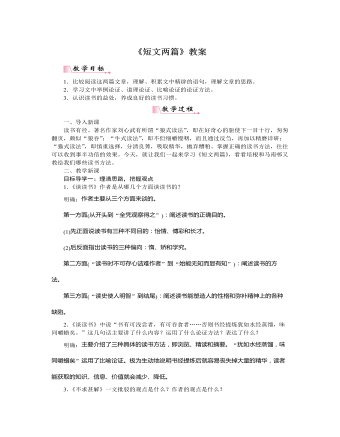
部编版语文九年级下册《短文两篇》教案
4.《不求甚解》一文分析了陶渊明怎样的读书态度,请指出“不求甚解”的两层含义。明确:态度:养成“好读书”的习惯;读书要诀在于“会意”。含义:第一,虚心,书不一定都能读懂;第二,读书方法:不固执一点,而要了解大意。5.《不求甚解》一文是驳论文还是立论文?又是如何驳或者立的?谈一谈你的理解。明确:驳论文。驳的是“论点”,先全面阐述“不求甚解”的含义,进而提倡虚心的“不求甚解”的读书态度,从而表明自己的观点;又从“会意”角度,列举古人读书的例子,并阐明自己的正确论点:读书在会意,不要死抠字眼,为一个局部而放弃整体;最后又强调了“书必须反复读”的主张。这样通过树立自己正确的观点从而驳倒敌论。

部编人教版四年级下册《文言文二则》创新教案
三、教学过程(一)导入新课:1.师:同学们,中国是世界上历史最悠久的国家之一,在漫漫的历史长河中,产生了大量的神话传说和历史故事,后来人们把这些神话传说和历史故事加以锤炼,便形成了许多脍炙人口的成语。下面,让我们一起来感受下中华语言文化的精华,背诵下我们积累的成语。)2.学生起头,背诵成语接龙。(在今后的学习中我们还会积累更多的成语,希望同学们继续保持这种学习精神。)3.导入:成语是我国语言文化的精华,它们有的庄重严肃,有的机智幽默,而且大多数的成语背后都有一个生动的故事。今天老师给大家带来个有趣的成语故事,大家想不想看?这个成语故事的名字叫做“铁杵成针”。(板书课题:铁杵成针)不过,老师有个要求,希望同学们能带着这些问题认真去观看。

部编人教版四年级下册《文言文二则》教案
一、谈话交流,导入课题。1.同学们,《凿壁偷光》的故事大家听说过吗?【课件出示2:图文】匡衡勤奋好学,可是家境贫寒,晚上想读书而无烛照明。邻居家倒是每到夜晚,总烛光明亮,可惜这光照不到他匡衡的屋里。怎么办呢?匡衡便把自己家靠邻舍的那堵墙壁凿开一个洞以引邻居家的烛光来读书。古时候,还有一位热爱读书的人,他是晋代车胤,因为家贫,没钱买灯油,而又想晚上读书,便在夏天晚上抓一把萤火虫来当灯读书。2.这个故事就是《囊萤夜读》,今天,我们来学习一下这个小故事。(板书:囊萤夜读)学生齐读课题。3.这是一篇文言文。千古传诵,流传至今。4.补充文言文知识:文言文人们通常说古文。我国是一个文明古国,我国古代有着灿烂的文化,有着浩如烟海的文学艺术瑰宝,他们都是以文言文的形式记载下来的。我们要去传承民族的瑰宝,就要学好文言文。【课件出示3】
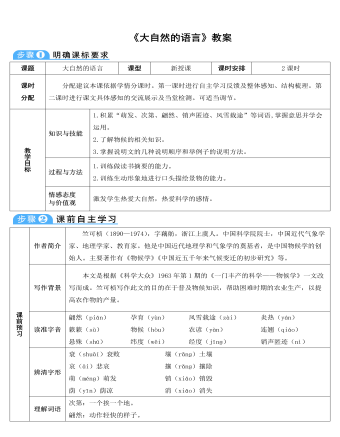
部编版语文八年级下册《大自然的语言》教案
结束这节课,我心里很轻松,因为在以往的教学中学生感觉到:说明文很单调、枯燥不生动。而本节课学生与我配合得非常好,原因是我利用多媒体展示的几幅画面,把学生的注意力都集中在所讲的内容中,并且调动了学生学习的积极性,认为物候现象就在我们的身边,激发学生探索科学奥秘的兴趣,更多地去了解大自然,认识大自然,热爱大自然。在初读课文的时候,我训练了学生的概括能力;在分清举例说明的方法时,让学生明白什么是举例子的说明方法;在细读课文的时候,让学生学习生动地有条理地说明事物的方法,还重点品味第一段的生动语言,在品味说明文语言的准确性时,有日常生活中的例子导入,深入浅出地讲解了说明语言准确性的两点情况。
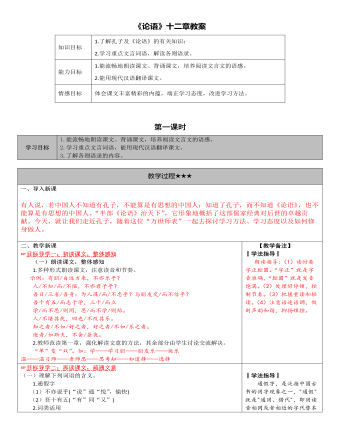
部编版语文七年级上册《论语》十二章教案
2.在新知与旧知、知识与实践的关系上,在学与思、学与问的关系上,孔子是怎么看的?新知与旧知的关系上,孔子认为“温故”可以“知新”。也只有“温故”“知新”的人才能当老师。这里,孔子强调的是“新知”,是那种开拓、创新的精神。在知识与实践的关系上,孔子认为“学而时习之”。学了知识要按时去实习,把所学的东西运用到行动上,在实践中提高对知识的掌握程度。在学与思的关系上,孔子认为学习与思考必须结合,二者缺一不可。只读书而不通过自己的头脑加以思考,就会感到迷惑;只是一味空想而不读书,就会精神疲惫。在学与问的关系上,孔子主张既学又问,不仅问知识才能比自己高的人,即使是知识才能比自己低的人,只要他们在某一方面有一技之长、一得之见,就应该虚心向他们求教,不以为羞耻。
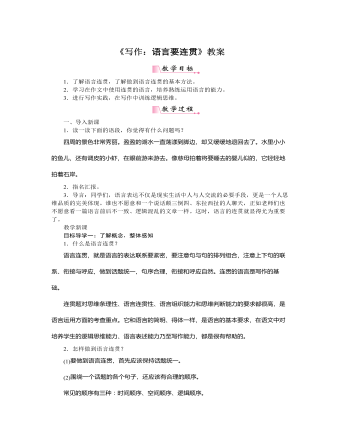
部编版语文八年级上册《写作:语言要连贯》教案
(3)也可以用散文的形式将某一个传统节日的历史渊源娓娓道来,从宏观层面追溯千年历史。2.佳作欣赏节 日在一阵阵爆竹声中,一阵阵欢歌笑语中,我们终于迎来了春节!春节,是中国最盛大的节日,也是我们最高兴的日子。家家张灯结彩,街面上修饰一新,一派喜气洋洋的景象。爸爸妈妈也早早地把家里布置一新,置办了年货,我幸福地眨着眼睛,穿着新衣服在大衣柜镜子前照来照去,真是美极了!大年三十,爸爸领着我把鲜红的对联贴在院门上,那喜庆的金字映衬得我家满院都生辉了。最温馨的是除夕晚上,全家围坐在一起吃着香气四溢的年夜饭,看着异彩纷呈的春晚节目……心中感到是那样的温暖。

